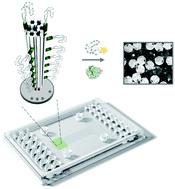当前位置:
X-MOL 学术
›
J. Mater. Chem. B
›
论文详情
Our official English website, www.x-mol.net, welcomes your
feedback! (Note: you will need to create a separate account there.)
Boosting biomolecular interactions through DNA origami nano-tailored biosensing interfaces.
Journal of Materials Chemistry B ( IF 6.1 ) Pub Date : 2020-04-29 , DOI: 10.1039/c9tb02439e Iene Rutten 1 , Devin Daems , Jeroen Lammertyn
Journal of Materials Chemistry B ( IF 6.1 ) Pub Date : 2020-04-29 , DOI: 10.1039/c9tb02439e Iene Rutten 1 , Devin Daems , Jeroen Lammertyn
Affiliation

|
The interaction between a bioreceptor and its target is key in developing sensitive, specific and robust diagnostic devices. Suboptimal interbioreceptor distances and bioreceptor orientation on the sensor surface, resulting from uncontrolled deposition, impede biomolecular interactions and lead to a decreased biosensor performance. In this work, we studied and implemented a 3D DNA origami design, for the first time comprised of assay specifically tailored anchoring points for the nanostructuring of the bioreceptor layer on the surface of disc-shaped microparticles in the continuous microfluidic environment of the innovative EvalutionTM platform. This bioreceptor immobilization strategy resulted in the formation of a less densely packed surface with reduced steric hindrance and favoured upward orientation. This increased bioreceptor accessibility led to a 4-fold enhanced binding kinetics and a 6-fold increase in binding efficiency compared to a directly immobilized non-DNA origami reference system. Moreover, the DNA origami nanotailored biosensing concept outperformed traditional aptamer coupling with respect to limit of detection (11 × improved) and signal-to-noise ratio (2.5 × improved) in an aptamer-based sandwich bioassay. In conclusion, our results highlight the potential of these DNA origami nanotailored surfaces to improve biomolecular interactions at the sensing surface, thereby increasing the overall performance of biosensing devices. The combination of the intrinsic advantages of DNA origami together with a smart design enables bottom-up nanoscale engineering of the sensor surface, leading towards the next generation of improved diagnostic sensing devices.
中文翻译:

通过DNA折纸纳米定制的生物传感界面促进生物分子相互作用。
生物受体与其靶标之间的相互作用是开发灵敏,特异和耐用的诊断设备的关键。由于不受控制的沉积,传感器表面上的生物受体距离和生物受体取向都不理想,这会阻碍生物分子相互作用并导致生物传感器性能下降。在这项工作中,我们研究并实施了3D DNA折纸设计,这首次包括专门针对创新型EvalutionTM平台的连续微流体环境中盘状微粒表面上生物受体层的纳米结构的纳米结构的专门定制的锚定点的测定方法。这种生物受体固定化策略导致形成了密度较小的表面,减少了空间位阻,并有利于向上定向。与直接固定的非DNA折纸参考系统相比,这种增加的生物受体可及性导致结合动力学提高4倍,结合效率提高6倍。此外,在基于适体的夹心生物测定中,DNA折纸纳米定制生物传感概念在检测限(提高了11倍)和信噪比(提高了2.5倍)方面,优于传统的适体耦合。总之,我们的结果强调了这些DNA折纸纳米定制表面在改善传感表面上生物分子相互作用方面的潜力,从而提高了生物传感设备的整体性能。DNA折纸的固有优势与智能设计相结合,可以对传感器表面进行自底向上的纳米级工程设计,
更新日期:2020-01-09
中文翻译:

通过DNA折纸纳米定制的生物传感界面促进生物分子相互作用。
生物受体与其靶标之间的相互作用是开发灵敏,特异和耐用的诊断设备的关键。由于不受控制的沉积,传感器表面上的生物受体距离和生物受体取向都不理想,这会阻碍生物分子相互作用并导致生物传感器性能下降。在这项工作中,我们研究并实施了3D DNA折纸设计,这首次包括专门针对创新型EvalutionTM平台的连续微流体环境中盘状微粒表面上生物受体层的纳米结构的纳米结构的专门定制的锚定点的测定方法。这种生物受体固定化策略导致形成了密度较小的表面,减少了空间位阻,并有利于向上定向。与直接固定的非DNA折纸参考系统相比,这种增加的生物受体可及性导致结合动力学提高4倍,结合效率提高6倍。此外,在基于适体的夹心生物测定中,DNA折纸纳米定制生物传感概念在检测限(提高了11倍)和信噪比(提高了2.5倍)方面,优于传统的适体耦合。总之,我们的结果强调了这些DNA折纸纳米定制表面在改善传感表面上生物分子相互作用方面的潜力,从而提高了生物传感设备的整体性能。DNA折纸的固有优势与智能设计相结合,可以对传感器表面进行自底向上的纳米级工程设计,











































 京公网安备 11010802027423号
京公网安备 11010802027423号